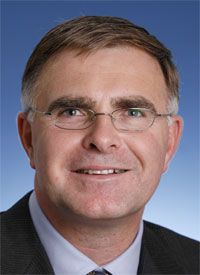Frontline Daratumumab Triplet Seeking FDA Approval in Multiple Myeloma
FDA approval is being sought for the combination of daratumumab with lenalidomide and dexamethasone for the treatment of newly diagnosed patients with multiple myeloma who are not candidates for high-dose chemotherapy and autologous stem-cell transplant. Genmab, which co-develops daratumumab with Janssen Biotech, announced that a supplemental Biologics License Application has been initiated with the FDA.

Jan van de Winkel, PhD
FDA approval is being sought for the combination of daratumumab (Darzalex) with lenalidomide (Revlimid) and dexamethasone (DRd) for the treatment of newly diagnosed patients with multiple myeloma who are not candidates for high-dose chemotherapy and autologous stem-cell transplant (ASCT). Genmab, which co-develops daratumumab with Janssen Biotech, announced that a supplemental Biologics License Application (sBLA) has been initiated with the FDA.
The sBLA is based on findings from the phase III MAIA study in which the DRd regimen reduced the risk of disease progression or death by 44% compared with lenalidomide plus dexamethasone (Rd) alone in this patient population. At a median follow-up of 28 months (range, 0.0-41.4), the median progression-free survival (PFS) had not been reached with DRd compared with 31.9 months in the Rd group (HR, 0.56; 95% CI, 0.43-0.73; P<.0001). The PFS rate at 30 months was 71% versus 56%, respectively.
The overall response rate (ORR) was 93% with DRd compared with 81% with Rd (P<.0001). The stringent complete response (sCR) rate (30% vs 12%), CR rate (17% vs 12%), and very good partial response (VGPR) rate (32% vs 28%) were all higher with DRd versus Rd. The PR rate was higher in the Rd versus DRd group at 28% versus 14%, respectively. The MRD-negative rate was greater than threefold higher with DRd versus Rd at 24% versus 7%, respectively.
“We are encouraged that the submission for daratumumab in combination with lenalidomide and dexamethasone has begun, with a potential for the regimen to be approved earlier for US patients,” Jan van de Winkel, PhD, chief executive officer of Genmab, said in a statement.
The open-label, multicenter phase III MAIA trial included 737 newly diagnosed patients with multiple myeloma who were not candidates for high-dose chemotherapy and ASCT. Fifty-two percent of patients were male and 92% were white. The ECOG performance status was 0-1 for 83% of patients.
The median patient age was 73 years (range, 45-90). Only 1% of patients were aged <65 years, while 44% of patients were aged ≥75 years. Per the multiple myeloma international staging system, 27% of patients were stage I, 43% of patients were stage II, and 29% of patients were stage III. Of the total population, cytogenetic risk level could be determined for 642 patients. Eighty-six percent of these patients were standard risk and 14% of these patients were high risk.
Patients were randomized to lenalidomide (25 mg orally on days 1-21 of each 28-day cycle) and dexamethasone (40 mg once a week) with or without daratumumab. Daratumumab was administered at 16 mg/kg weekly for the first 8 weeks (cycles 1 and 2), every other week for 16 weeks (cycles 3 to 6), and then every 4 weeks (cycle 7 and beyond) until disease progression or unacceptable toxicity. PFS was the primary endpoint.
The most common grade 3/4 hematologic treatment-emergent adverse events (TEAEs) in the DRd arm were neutropenia (50% versus 35% with Rd), lymphopenia (15% vs 11%, respectively), anemia (12% vs 20%), and thrombocytopenia (7% vs 9%).
The most frequently occurring nonhematologic TEAEs in the DRd arm included pneumonia (14% vs 8% with Rd); fatigue (8% vs 4%, respectively); diarrhea (7% vs 4%); deep vein thrombosis, pulmonary embolism, or both (6% in each arm); asthenia (4% in each arm); back pain (3% in each arm); constipation (2% vs <1%); peripheral edema (2% vs <1%); and nausea (1% vs ≤1%).
Frontline daratumumab was previously approved in multiple myeloma for use in combination with bortezomib (Velcade), melphalan, and prednisone (VMP) for the treatment patients who are ineligible for ASCT. However, the VMP regimen is mostly utilized in Europe, not in the United States.
The ongoing Cassiopeia trial is examining daratumumab in combination with bortezomib (Velcade), thalidomide, and dexamethasone (VTD) as a frontline treatment for transplant-eligible patients with newly diagnosed multiple myeloma (NCT02541383).
Reference:
Facon T, Kumar SK, Plesner T, et al. Phase 3 Randomized Study of Daratumumab Plus Lenalidomide and Dexamethasone (D-Rd) Versus Lenalidomide and Dexamethasone (Rd) in Patients with Newly Diagnosed Multiple Myeloma (NDMM) Ineligible for Transplant (MAIA). Presented at: ASH Annual Meeting and Exposition; December 4-8, 2018; San Diego, California. Abstract LBA-2.
Gasparetto Explains Rationale for Quadruplet Front Line in Transplant-Ineligible Myeloma
February 22nd 2025In a Community Case Forum in partnership with the North Carolina Oncology Association, Cristina Gasparetto, MD, discussed the CEPHEUS, IMROZ, and BENEFIT trials of treatment for transplant-ineligible newly diagnosed multiple myeloma.
Read More